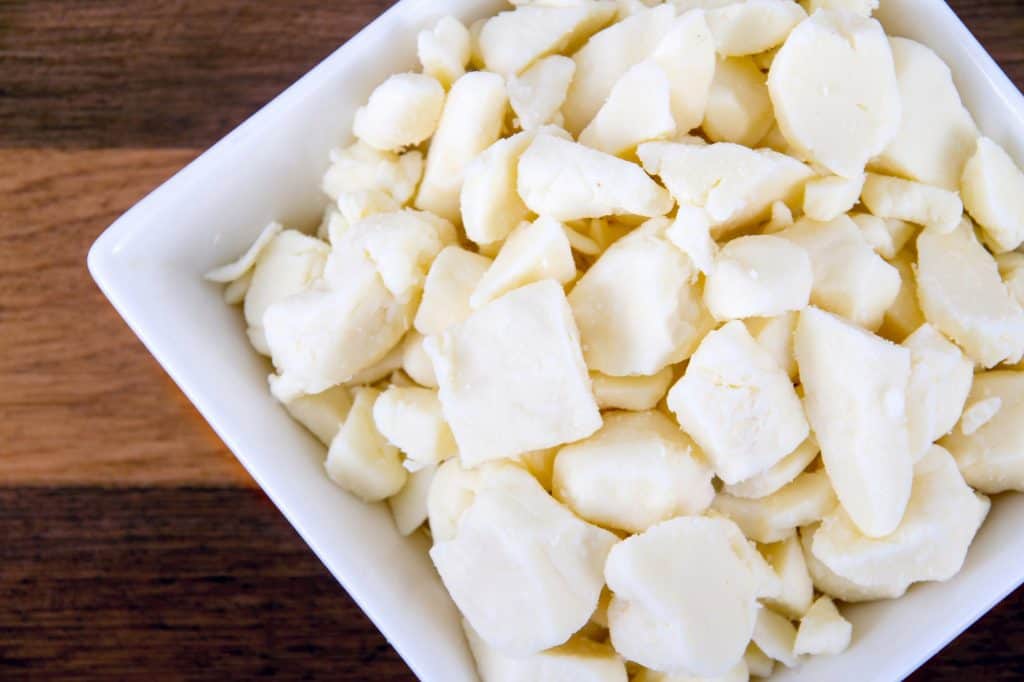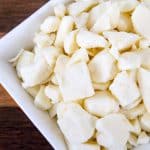
If you’re imagining small, high-pitched screaming curds when I say “squeaky cheese curds”, I don’t blame you. I did as well once.
Cooked curds refer to heated milk curds that you get during the cheese-making process of hard types of cheeses such as Cheddar. Only less-pressed and less aged.
They have a mild taste and squeak when you bite them. The trouble with preparing these curds is the necessity of perfect timing, as they lose their “squeakiness” every single day of aging. That means don’t cook them if you’re not going to eat them right away, or within the next 5 days.
This treat is the favorite snack for many turophiles. It’s delicious and you can combine them with other foods, or put them in a bag and eat like a snack. You can also melt them over a pizza or lasagna.
Before we dive into the recipe, for all of you who are new to preparing dairy products at home, I’ll now shortly explain what cheese curds are and how is it possible for them to squeak.
Table of Contents
What Are Cheese Curds?
Every cheesemaking process usually begins with fermenting the milk. The most common result of milk fermentation is the separation between the whey and the curd. When that happens, I usually press that curd to create cheese. Everything that doesn’t end up as cheese are cheese curds and many people like to eat them as a snack.
The main difference between cheese curds and actual cheese is that the former is the byproduct of the latter. Also, cheese curds are best eaten fresh, as they tend to age quickly and lose their squeakiness. Cheese on the other hand only gets better with age.
A lot of people think of cheese curds as some special type of cheese. However, it’s not, they’re more like baby Cheddar – the one that hasn’t aged a bit. To be more specific, they are a part of the Cheddar-making process, which was initially developed to enable the Cheddar cheese to age for years.
Ironically, curds became a much more popular snack than Cheddar became cheese, and they shouldn’t be left to age a bit!
What Is Squeaky Cheese?
Squeaky cheese is young and fresh cheese curds, formed during making Cheddar cheese. They are so young, they make a squeaking sound when you chew on them due to their rubbery texture.
This treat needs to be eaten right away, as it loses its texture (which it’s famous for) with every hour of aging.
Would you like to learn how to prepare this treat at home?
Then bear with me. In this article, I’ll teach you how to make your own squeaky cheese curds, how to store them, and how to mix with other food. Here we go!
Print
Squeaky Cheese Curd Recipe
- Total Time: 2 hours
Description
The recipe for squeaky curds is quite straightforward. You don’t need any special cooking skills, nor unusual equipment. Everything you need is available in the nearest grocery store, or maybe even in your fridge already.
As the curds are best when served and eaten right away, they don’t need to go through aging, nor waxing.
Ingredients
- 1 gallon of milk;
- ½ pack mesophilic culture OR 1/4 cup kefir or cultured buttermilk;
- ¼ teaspoon liquid rennet (single-strength, vegetarian, or crushed) dissolved in 2 tablespoons water;
- ¼ teaspoon calcium chloride dissolved in 2 tablespoons water;
- 1 tablespoon of non-iodized salt.
Equipment
- Two pots with lids. One should be bigger, so the other can easily fit in it;
- Thermometer;
- Stirring spoon or ladle;
- Long knife;
- Colander that fits the small pot;
- A clean cloth or muslin;
- Two clean ziplock bags for storing.
Instructions
There are 8 simple steps you need to follow to prepare the perfect squeaky curd. Let’s dive into it.
1. Heat the Milk
The first step is quite simple: you need to heat the milk to a temperature of some 95F. Use the thermometer for this and try not to let the temperature go below 90F or over 96F. Once your milk hits the desired heat, set the timer for 90 minutes.
2. Stir in Calcium Chloride and Mesophilic (or Other) Starter Culture
Add half-a-teaspoon Calcium Chloride and half-a-pack mesophilic culture. 1/4 cup other starter culture. Don’t let the milk temperature fall down and let it sit for 30 minutes.
3. Add Rennet
Take your desired rennet and dissolve ¼ teaspoon in 2 tablespoons water. Add it to milk and stir continuously for at least 30 seconds.
Give it another 10 minutes and you’ll be able to see how milk is becoming more gelly. In half-an-hour, you should see the curd forming. Take the knife and check its firmness. If you form a cut on the curd, it should fill with whey. If it doesn’t, wait a bit more – up to 15 minutes.
4. Cut the Curd
Since your curd will probably be in one piece, you should cut its surface into cubes. Leave it for 5 minutes before you start to stir. Don’t let the milk temperature fall below 90F, keep measuring it as you stir. After a couple of minutes, the curds should start shrinking.
5. Cook the Curds
The next step is cooking the curds at 115F for half-an-hour. As they boil, they’ll release more whey and shrink further. Don’t stop the stirring: use the ladle every 5 minutes.
The longer you cook them the drier they get, so you need to decide when to stop according to your taste. However, don’t cross 1 full hour.
6. Draining and Pressing
Use the cloth to incase the colander. Pour the curds inside, gather the cloth’s corners and leave it to hang for 30 minutes top. When the time is up, twist the muslin tightly to bring the curds together. Place some 8lbs weight on top of it and leave for 30 minutes.
7. Breaking and Salting
After half-an-hour, the curds should have formed a single mass. Break them with your fingers into pieces sized according to your preference and sprinkle some salt.
8. Storing
Store the curds in clean ziplock bags and put them in the fridge. They should be good for 5 days tops, although they’re best if you eat them right away.
- Prep Time: 2 hours
- Category: Cheese
FAQ
What Kind of Cheese Is Squeaky Cheese?
Squeaky cheese is not exactly cheese itself, but if I’d have to say, it’s a young Cheddar cheese. It got its name due to its rubbery texture that makes a squeaking sound when you bite on it.
How Do I Serve Squeaky Cheese?
Squeaky cheese can be served with many types of food. Here’s a list of my recommendations:
- Prepare breaded squeaky cheese;
- Eat as a snack;
- Use as olive stuffing (and add to cocktails or eat as bites);
- Mix with scrambled eggs;
- Eat them on poutine;
- Put it in a salad;
- Mix with grilled vegetables;
- Cover with olive oil and mix with spices to prepare a marinade.
Related posts
The Bottom Line
Squeaky cheese has a rubbery texture and it feels great to eat this great and healthy snack – priceless.
If your previous experience with this type of cheese was the store-bought version, brace yourself for something great: the homemade recipe is much better than the ready-made version.
If you want the full experience of squeaky cheese, make sure to eat it while it’s fresh. With every hour of sitting in the fridge, it loses its texture.
Combine squeaky cheese curds with other simple dishes to enjoy them more: combine them with poutine, olives, put them in a salad, or combine with grilled veggies. They also go well with meat in a form of a marinade.
HAVE QUESTIONS OR COMMENTS?
Join our Fermented Foods Community.

Thank you for the article. It was very useful. I can hardly wait to try making squeaky cheese.
Thanks Wonona. Hope you got a chance to make the cheese. 🙂
Great recipe; perfect squeakers!